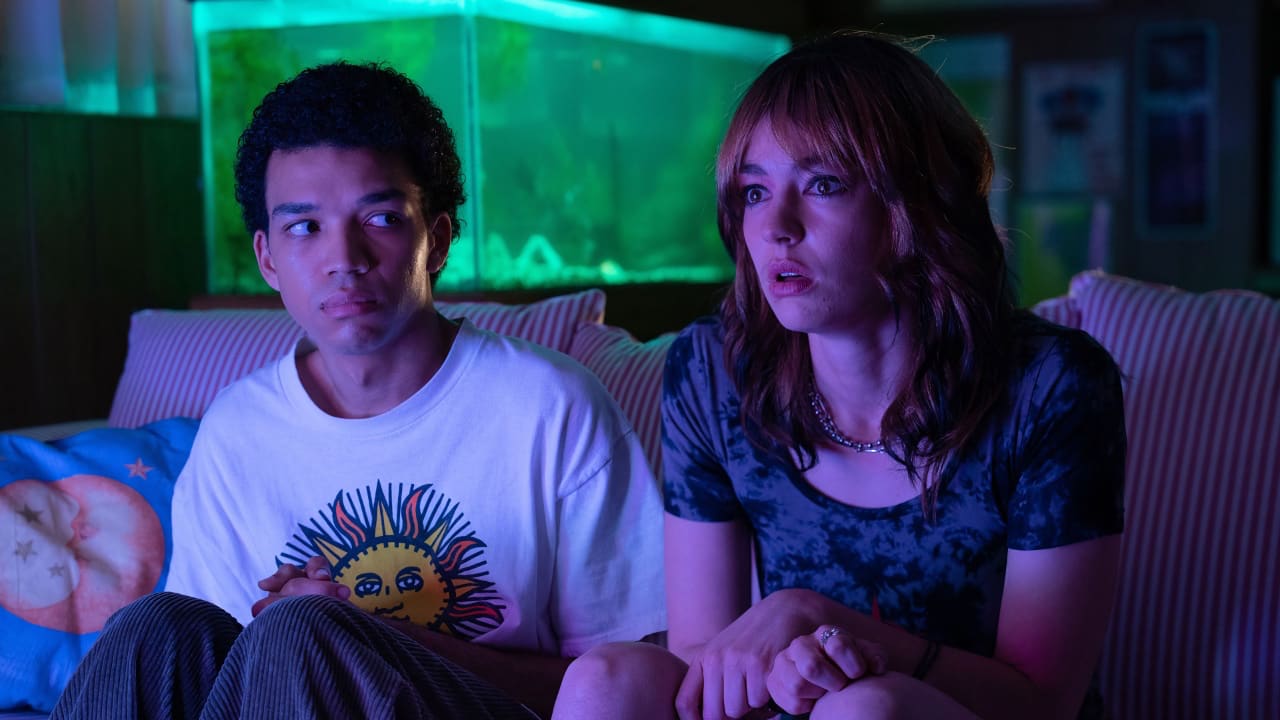
Emo horror movie I Saw the TV Glow is one of the first titles to make a big noise at this year’s Sundance, so we interviewed editor Sofi Marshall on how the film came together and the challenges in cutting it.
I Saw the TV Glow is the latest Sundance hit from director Jane Schoenbrun, whose 2021 movie We’re All Going to the World’s Fair was also a hit for them in Park City. What's more, according to Sundance itself, it “introduced us to a new genre of their own design: emo horror,” a vibe that I Saw the TV Glow is definitely emulating.
Glow has got some rave reviews so far, not least because there's a whole generation that cannot even think of a glowing TV without also thinking Poltergeist. Teenager Owen (Justice Smith) is trying to make it through life in the suburbs when his classmate Maddy (Brigette Lundy-Paine) introduces him to a mysterious late-night TV show — a vision of a supernatural world beneath their own. In the pale glow of the television, Owen’s view of reality begins to crack.
Sounds good; is proving very buzzy. So, we talked to editor Sofi Marshall about her work on the project.
RedShark: How did you get involved with I Saw the TV Glow?
Sofi Marshall: The director, Jane Schoenbrun, and I have been friends for a long time—we actually went to college together. We had also worked together previously on a gorgeous film that Jane produced called Chained for Life. When I read the script for I Saw the TV Glow, I immediately connected with the main character, Owen, who’s a relatively numb, shutdown kid growing up in the suburbs. Jane tapped into so many painfully relatable moments from my own childhood, all while beautifully capturing the nostalgia of the ‘90s. Needless to say, we clicked creatively, and we were both excited to work together again.
RS: How did you work together? What workflow did you establish with them?
SM: The entire post-process was super collaborative. During the shoot, my assistant, Janna Emig), and I put together the assembly as dailies came in and often shared rough sketches with Jane so they could see how the film was coming together. Once production wrapped, Jane and I worked together most days. Typically, we would collaborate for a few hours on specific areas of the film, and then I would go off on my own to work on outstanding notes. Since we were aligned on the aesthetic of the film from the beginning, there was a lot of trust between us. Jane could rattle off a list of changes and know that I would execute them in full support of their vision.
I should also say that even though we worked together extensively, Jane and I were never actually in the same room! During the pandemic, I developed a simple workflow for real-time remote collaboration that allows me to stream my edit timeline. I Saw the TV Glow was edited entirely remotely using that setup. Overall, the edit, including working with Jane, was an amazingly seamless experience.
RS: What were the main editing challenges on the film?
SM: Much of Owen’s journey in the film is internal. He’s a quiet, shy kid who’s trying really hard to avoid knowing himself, scared of what he might find. One of my goals was to try to make his emotional journey as external as possible, so that the audience has the opportunity to deeply connect with him. That inevitably led to a few “kill your darlings” moments.
One example - initially, there was a longer, more sprawling opening montage that was absolutely gorgeous but much less focused on Owen as the main character. Ultimately, we realized that Owen needed to be front and center and that many of the moments we loved were distracting the audience from connecting with him. Cutting some of those beautiful shots seriously hurt, but it was the right decision in the end.
Another challenge that we faced was finding the right rhythm and pacing. There are several montages meant to pass time as Owen ages, as well as a number of scenes with a ton of cross-cutting. It took a lot of back and forth to strike the right balance between focusing on the emotional quality of these moments, and the story points that we needed to convey. Each had a ton of moving pieces, often with disparate moods, that needed to be massaged into a single, cohesive sequence. Ultimately, we allowed ourselves plenty of room to play, going back and forth on including, cutting, or trimming shots over and over until Jane and I felt we had pretty much tried everything.
RS: You’re a Premiere Pro user. What tools and features did you use to get around those challenges?
SM: Premiere Pro has been my go-to NLE for years. I find it to be the most intuitive, user-friendly, and customizable NLE out there.
The Premiere feature I probably relied on most was remix—a tool that lets you re-time music tracks to custom lengths. Music plays a huge role in the film, and as we continued to refine complex sequences, the length of the underlying tracks changed daily if not minute by minute. Remix made it easy to re-time the music as many times as we needed.
I’m also fully devoted to Premiere’s keyboard-based trim tools. They’re a lot more robust than people realize. Case in point - any director I’ve worked with will tell you that I’m a huge tea drinker. Premiere’s trim tools let me hold my mug in one hand and make edits with the other, all without ever leaving the keyboard.
Finally, we, of course, set the film up as a Production. Since my assistant and I were working remotely, we needed to share timelines and assets back and forth daily, and Productions was a lifesaver.
Tags: Post & VFX


Comments